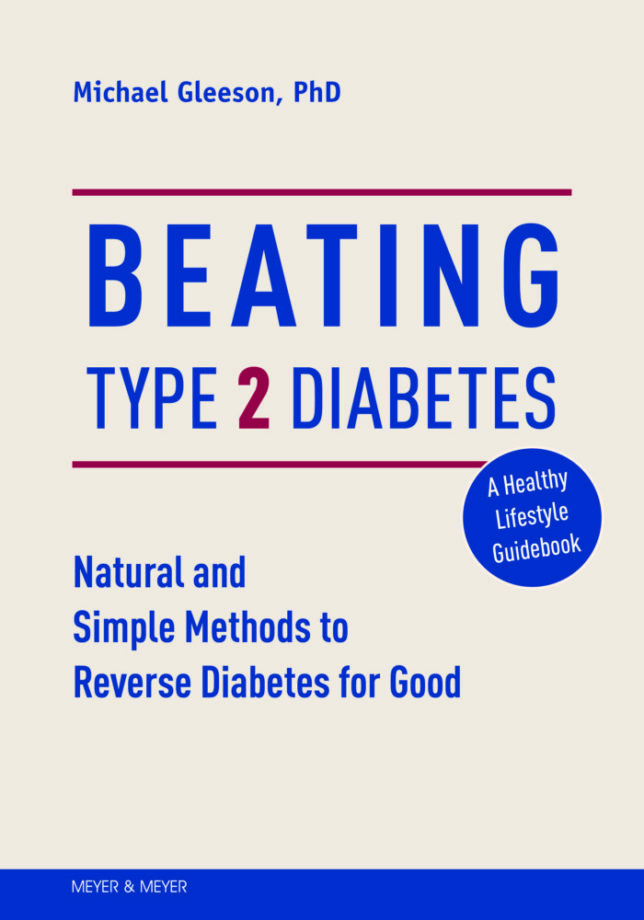By Emeritus Professor Michael Gleeson, PhD – Chair in Exercise Biochemistry at Loughborough University and author of ‘Beating Type 2 Diabetes’ – a life-changing and potentially life-saving book for people with this serious condition.
The huge and growing problem of type 2 diabetes already affects about 4 million people in the UK. Around three times as many more are in the early stage of the disease (a condition called prediabetes) or are at high risk of developing it within five years. Worryingly, it is estimated that about one million British people actually have type 2 diabetes but don’t yet realize that they do.
Type 2 diabetes is a metabolic disease that affects how the body deals with glucose (blood sugar), the primary source of energy that our cells rely on. This change in the body’s handling of glucose results in the main dangers of type 2 diabetes which include substantially higher risks of coronary heart disease, stroke, kidney disease, infections, ulcers, and blindness. Oh, and it will also knock five to ten years off your expected lifespan!

One of the main problems with type 2 diabetes is that it creeps up on you, and especially in the early stages of the disease, the symptoms may be absent or not obvious with no overt signs of feeling unwell. But high blood sugar levels are the first real indication that something is wrong and always precede the onset of type 2 diabetes. Some symptoms that should give you cause for concern include feeling tired, hungry and thirsty much of the time, needing frequent visits to the toilet to pee, feelings of numbness or tingling in your hands or feet, unexpected weight loss, blurred vision and erectile dysfunction in men.
If any of these symptoms affect you it is best to tell your doctor who may first check your urine to see if any glucose is present which there shouldn’t be if you don’t have any form of diabetes. Diagnostic confirmation of the condition requires a blood test to determine if you have a sustained elevation of your blood glucose level. This is based on a single measurement of the concentration of glycated haemoglobin, known as HbA1c, which should normally be below 5.7%; if it is between 5.7 and 6.4% you are diagnosed as being prediabetic and if it is 6.5% or more you have become a type 2 diabetic.
By far the biggest risk factor for type 2 diabetes is being overweight, or more accurately having too much fat, particularly in the belly area. Research in recent years has shown that for the majority of people it is possible to reverse type 2 diabetes and actually get rid of it if you can lose that excess weight through strict dieting.
The NHS now offers a programme based on this research in which you stick to a very low-calorie diet (that is about only 800 calories per day which is about 1,200 calories below what an average person needs) until you have lost the amount of desired weight (typically 10-20 kilograms depending on how overweight you are). For most people that takes several months and is not an easy plan to stick to or a pleasant experience because it consists of consuming mostly soups and shakes. Indeed it comes with support and counselling from NHS staff to help people to stick with it.
But there is an alternative which many people could find easier by using a more varied, healthier and less drastic diet plan combined with just being more physically active. You still can achieve the same calorie deficit as the NHS plan but you do it with a combination of less drastic dieting and some extra exercise: you reduce your daily calorie intake by about 600 calories and burn about 600 calories per day through exercise. This is because the more calories you burn with exercise the less drastic your dieting can be and besides exercise is known to increase glucose removal from the blood and oppose insulin resistance which is the main problem that results in type 2 diabetes.
In my book Beating Type 2 Diabetes I describe an effective weight loss plan that is well suited to people with prediabetes or Type 2 diabetes and uses sensible, varied, non-extreme dieting (typically allowing up to 1,400 calories per day on average), combined with enjoyable and exhilarating (but not exhausting) exercise that should kick diabetes into remission and improve many other aspects of health in the process.
The great thing about the diet part of my weight loss plan is that it does not require sticking with the same boring diet for week after week so most people will find it easier to stick to as well as being more varied and nutritious than the much stricter NHS option. I utilize a variety of different, but equally effective diets that can be changed on a weekly basis and in the book I have also devoted a chapter to describing meal ideas and recipes for all the diets in the weight loss plan.

I know this weight loss plan works as I used it successfully to get rid of type 2 diabetes myself when I was diagnosed with the condition seven years ago. I lost 10 kilograms in 10 weeks and that did the trick for me!
Here is a brief summary of the diets that work for weight loss and are suitable for people with prediabetes or type 2 diabetes:
Intermittent Fasting Diet
There are several different versions but I advocate using the 4:3 diet which involves eating normally on four days of the week and consume only about 500 calories on alternate days. Your meals on these days should be high in protein but low in fat and carbohydrate so think mostly lean meats or fish and green vegetables.
Reduced Fat Diet
Because fat is the most energy dense nutrient (each gram of fat contains 9 calories compared with only 4 for carbohydrate and protein), reducing the dietary fat intake from 25-30% to around 10-15 % of total energy intake can be a very effective way to reduce overall daily energy intake and promote weight loss. Eliminating all fat from the diet is not recommended as you will be missing essential fatty acids and fat-soluble vitamins. A moderate reduction in dietary fat is, however, very desirable and is best achieved by eliminating foods with high-fat content from the diet. That means cutting out fatty meats, sauces, cheese, creams, pizza, cakes, and cookies and substituting some foods or beverages with lower fat alternatives (e.g., skimmed milk, low-fat yoghurt, and reduced fat coleslaw).
Very Low Energy Diet
Essentially the same as the 800 calories per day diet promoted by the NHS but on my diet plan you only need to apply this on four days of the week.
High-Protein Diet
For most diets, protein will provide 10 to 15% of the calories; with a high-protein diet, this is increased to about 30% with a moderate reduction in fat and carbohydrate intake. One main reason that is often given for its effectiveness is that a high-protein diet suppresses the appetite, which might be a mechanism that could help to promote weight loss. In addition, compared with fat and carbohydrate, protein is generally less digestible meaning that a smaller percentage of its available energy is digested and absorbed. A high-protein diet can be even more effective if the carbohydrate foods you consume are low glycaemic index and you trim the fat off cuts of meat and avoid other high-fat foods.
Skip Lunch Diet
A very simple diet in which you just avoid eating anything at lunch-time! For most people that cuts out around 500 calories per day.
Low Energy Density Diet
A low energy density diet provides about 1,400 calories per day with an energy density of less than 1.5 calories per gram. The main principle of a low energy density diet is to avoid fatty foods (or use reduced fat versions of foods like cheese and milk), use only lean meat (trim off any visible fat and remove skin from poultry) and fish, and include lots of non-tropical fruit and non-starchy but bulky, high-fibre vegetables such as spinach, broccoli, cauliflower, green beans, or salad leaves with tomatoes, onion and celery.
Some of you may have spotted that I have not included the Low Glycaemic Index (GI) Diet in this list. The GI is a measure of how much a particular food item raises your blood glucose after eating an amount containing 50 grams of carbohydrate. Selecting foods that have a low GI value may help you manage your weight and control your blood sugar because many foods that should be included in a well-balanced, low-fat, healthy diet with minimally processed foods — wholegrain products, fruits, vegetables, and low-fat dairy products — have low GI values. Avoiding high GI foods generally means eliminating candy, chocolate, sugar-sweetened beverages, most sauces, many processed foods, and starchy vegetables like potato as well as rice, bread, and pasta from your diet. But a low GI diet does not specify portion sizes and to lose a significant amount of weight you will need to reduce your energy intake by at least 500 calories per day. For these reasons a low GI diet is not one I would recommend if your main goal is effective weight loss.
You can choose the diets that suit you best according to your personal preferences and to fit in with what you are doing that week. This is a very simple approach and you won’t get bored; every week will be different to the previous one. You can follow the suggested sequence in the list above which ensures you will be having different foods each week, or you can come up with your own sequence. To achieve the desired weekly dietary energy deficit on some diets (the 4:3 and very low energy diet) you won’t need to diet every day of the week. On the other days you can eat normally, but don’t overcompensate by eating more than usual. You could try out the Mediterranean or Japanese diet or go vegetarian on these days to add further healthy variety to your programme.
As for the exercise part of the weight loss plan it only involves doing light to moderate intensity aerobic activities (no high intensity training is involved here!) such as fast walking or jogging – many build up to jogging, cycling, swimming or aerobics for around 60-90 minutes in total per day. None of the exercises I recommend should leave anyone with aching muscles or feeling sick or tired – it’s not necessary.
The important message is that it is indeed possible for people to modify their current lifestyle for the better, get rid of their diabetes for good, improve their quality of life and actually live longer.
Eat, Move, Sleep, Repeat: Beating Type 2 Diabetes (£15.95), The Pick ‘n Mix Diet (£15.95) (Meyer & Meyer) and Beating Type 2 Diabetes (£16.95) by Professor Michael Gleeson (Meyer & Meyer) are out now in paperback and ebook.

